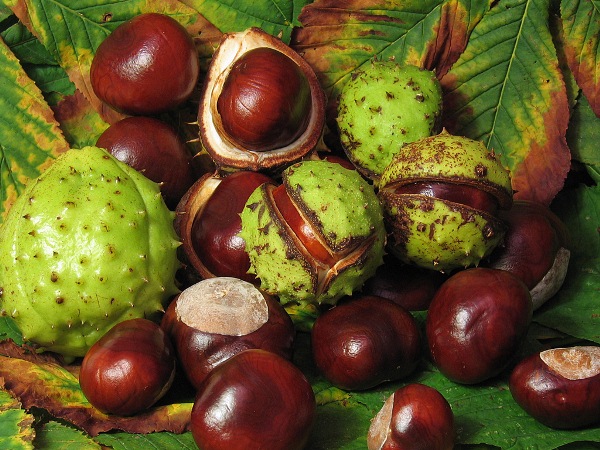Horse chestnut - a mighty tree with a chic thick crown, which can be seen in any park or yard. His greatness and beauty can not fail to amaze. It has long been used in folk medicine. to relieve symptoms and treat many diseases. A detailed description of this type of chestnut, healing properties, methods of reproduction, planting and care can be found below.
Table of contents
Morphological characteristics of horse chestnut
Horse Brown chestnut is a plant belonging to the family of the Horse-chestnut. It has a powerful root system that lies deep in the soil. The trunk is a powerful, dark brown color, crowned with a sprawling crown in the shape of a dome. Tall tree can reach up to 35 meters.
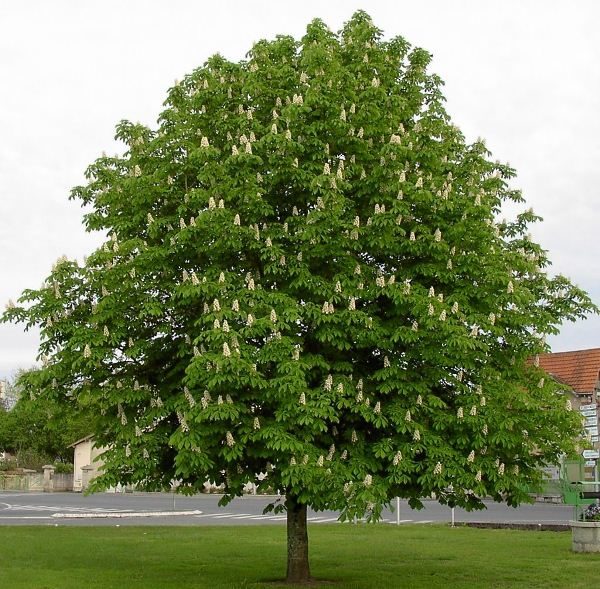
The leaves are pale green, palmate-complex and practically without denticles with oblong petioles. In spring, vegetation begins, and white flowers, enclosed in panicles, bloom. Every whisk has from 1 to 5 fruits that look like boxes covered with a lot of thorns.
If you open these boxes, you can find one or more nuts, which everyone calls chestnut. Walnut shiny dark brown, with a small rough constriction in the middle.
How and where does a tree grow
Horse chestnut came to us from the south side of the Balconian Peninsula. To be more precise - this is Albania, Bulgaria, Greece, Serbia, Macedonia. Mostly this plant in the wild grows in deciduous forests and feels comfortable next to the ash, alder, linden, maple. In the open spaces of the Russian Federation, ordinary horse chestnut is planted in a temperate zone.
Fruit horse chestnut is necessary collectwhen they start falling off on their own, this is a signal that they have already matured, mostly it happens in October.
How to eat fruit
Despite the fact that the nuts are similar to each other, but the fruits resemble only externally. Not all chestnuts can be eaten.. That is why it is no wonder horse chestnut has such a name, because its fruits can not be eaten by people. In places where it grows, it is given in pet food. To taste, these nuts are bitter, so the animals do not immediately begin to eat them. Usually, they are simply ground into flour and added as an additive to animal feed. What chestnut can you eat?
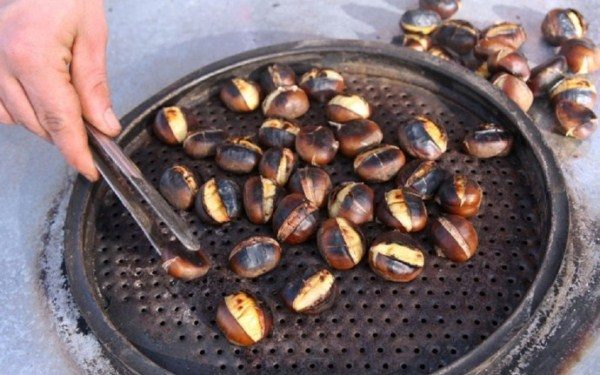
But the real chestnut can be eaten. In the south of Europe, it is eaten baked, raw, fried and boiled.. They make flour from dried fruits and add it to pastries, sweets, cakes. They can also be made a worthy replacement for coffee.
Useful properties and application in traditional medicine
Chestnut is a valuable nut, which has a large number of useful properties. It consists of:
- Saponins. They have a positive effect on the increase in the tone, permeability and elasticity of venous vessels, thereby removing blood stasis. Activates the production of catecholamines. Makes the walls of the venous capillaries stronger and eliminates pastoznost by lowering the lymph flow.
- Tannins. They are necessary to create protection, due to their bactericidal and astringent properties.
- Starch - the most important source of energy. When it enters the body, it turns into glucose. He is also responsible for coordinated muscle work.
- A large amount of vitaminswhich are so necessary for the human body: A, C, E, K, vitamins of group B.
- Glycosides essential for proper cardiac performance, improvement of the nervous system, urination, and removal of sputum from the lungs.
- Many macro and micronutrients: Ca, Fe, Ni, Zn, B, Cr, Se, I, Ag.
Also chestnut is enriched with pectin, lecithin, carotene, flavonoids and organic acids, globulins, fatty oils.
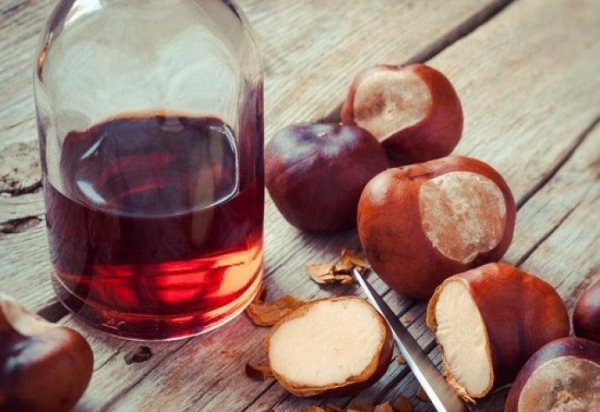
This rich composition can significantly improve human health, therefore, has found wide application in traditional medicine.What can help chestnut body:
- Removes pastosnostl and inflammatory reactions.
- Interferes with liquefaction blood.
- Reduces viscosity blood.
- Reduces permeability capillaries.
- Prevention with thrombosis.
- Leads back to normal pH gastric juice.
- Takes off muscle spasm.
- Normalizes secretion gallbladder.
- Speed up blood flow.
- Expands vessels.
- Reduces cholesterol.
- Improves performance heart and liver.
- Chestnut extract removes toxins, heavy metals, salts and radionuclides.
There are plenty of options for how to use chestnuts. With the purpose of treatment used flowers, the bark of young branches, seeds, peel seeds, leaves and fruits. Of them make infusions, decoctions, drops.
Contraindications to receive:
- individual intolerance;
- disease thrombocytopeniaor low blood clotting;
- sharp gastritis and a stomach ulcer;
- violation menstrual cycle;
- pregnancyespecially in the first trimester;
- atonic constipation;
- hypotension - decrease in arterial pressure.
How to plant ordinary chestnut
Flowering chestnuts - just a sight for sore eyes. Many people dream of planting this tree in their yard or dacha, but few know how to do it right. To get horse chestnut caught and pleased you with its beauty you need to read the following rules:
- To plant a chestnut is not necessary to buy seedlings, one mature chestnut will be enough.
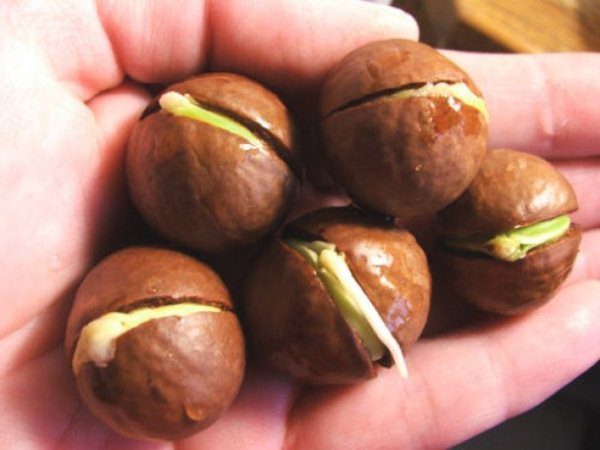
- To sprout a chestnut it is necessary soak in waterand when it swells and becomes saturated with moisture, it can be safely planted in the ground.
- Later 14 days there will be the first processes.
- When a chestnut has sprouted it can put in a pot of soil and leave in a cool room until spring comes.
- At the end of May, you can start landing. Better if it is not a particularly hot day.
- In order for seedlings to be stable and hardened, you can a few weeks before planting take them to fresh air and leave for a couple of hours. Next you need to leave for more time.
- Before planting chestnuts they should be on the street all day, and then another day.
First of all, you need to choose the right place for the future cultivation of chestnut. We must choose the territory so that it is well lit and has a lot of space and space. It is better not to plant chestnut in front of houses, outbuildings and enterprises. Also within 5 m there should not be any buildings that would interfere with the penetration of the sun into the crown. Another important point is that nothing obscures the seedlings.
The land should be fertile, fine, if it is black soil. If the soil is sandy or clayey, this can lead to rotting and acidification of the roots.. Also, the roots will get a little oxygen.
If the soil does not have any particular minerals or elements, then it is necessary to replenish the balance.For example, if it is a loamy type of soil, then you need to add sand, and if it is a sandy type, then clay. You can also use organic fertilizers such as compost or manure.
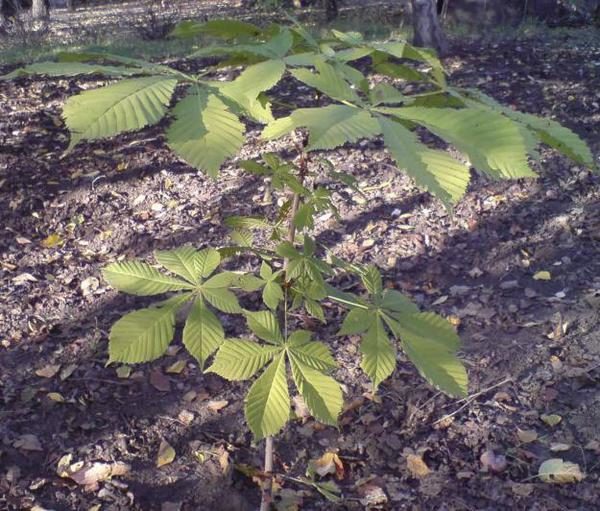
Planting a chestnut is not a difficult matter. To do this need to dig a hole wide 55-65cm. Next, you need to make fertilizer and mix it with the ground. Here you can use humus and dolomite flour.
Next, put a sapling and bury it with earth. After we tamp the earth with our hands and water it. It is worth remembering about weeding, in order for the roots to develop faster. You can also make a backup so that the tree does not break if there is a strong wind.
Chestnut care and reproduction
Although the horse chestnut tree is not whimsical, however, you should take care of it and properly care for it. Top dressing should be made in the fall. Nitroammofos can be used as a fertilizer.and after a year you can make the following fertilizer: pour 20 g of urea and 1 kg of mullein into a bucket of water. All components mix and water the seedling.
To saturate the soil with oxygen, one should not forget to mulch it and add peat or wood chips.
Summary
Horse chestnut is an amazingly beautiful tree with chestnuts, possessing a storehouse of useful substances. They are favorite plants that are used in landscape design. The most important thing to remember is that horse chestnut can not be consumed, and allowed only real chestnut.
Acceptance of infusions, decoction or self-use significantly improve health and enrich your body with vitamins and minerals.
In this way, This tree is not only the beauty and purification of the air, but also greatly affects the internal state. Since it is not expensive and easy to maintain, it is very advantageous to plant it in suburban areas, parks, highways.
